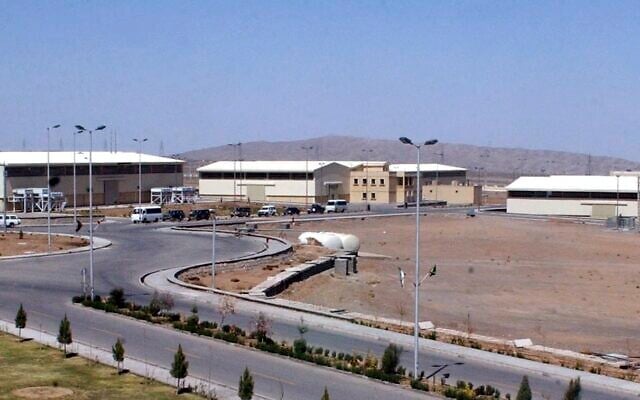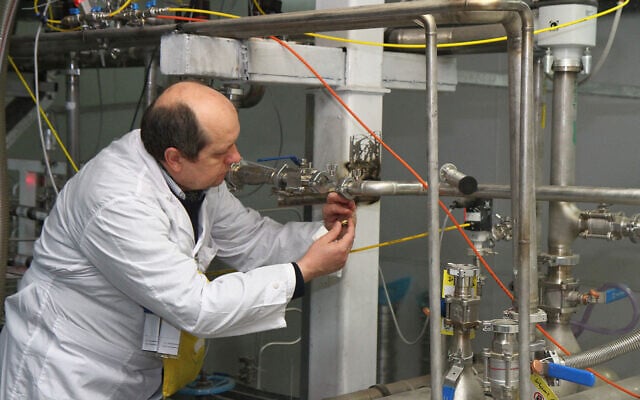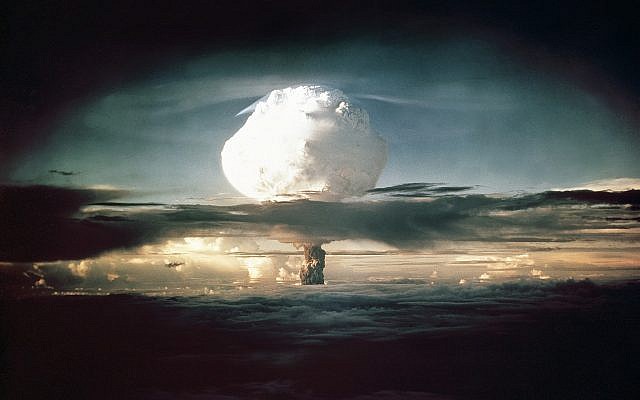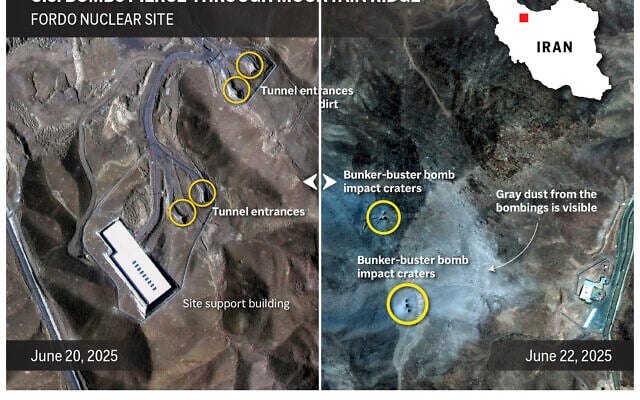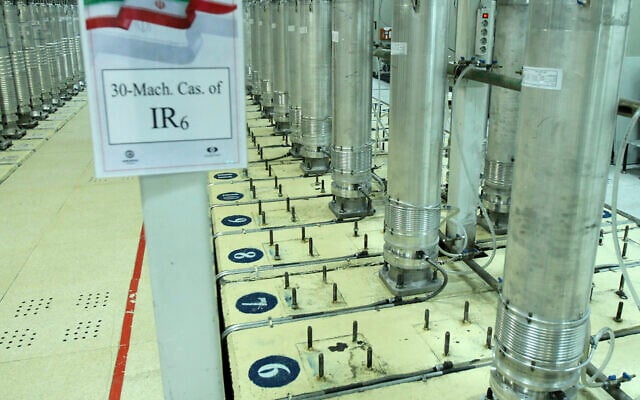


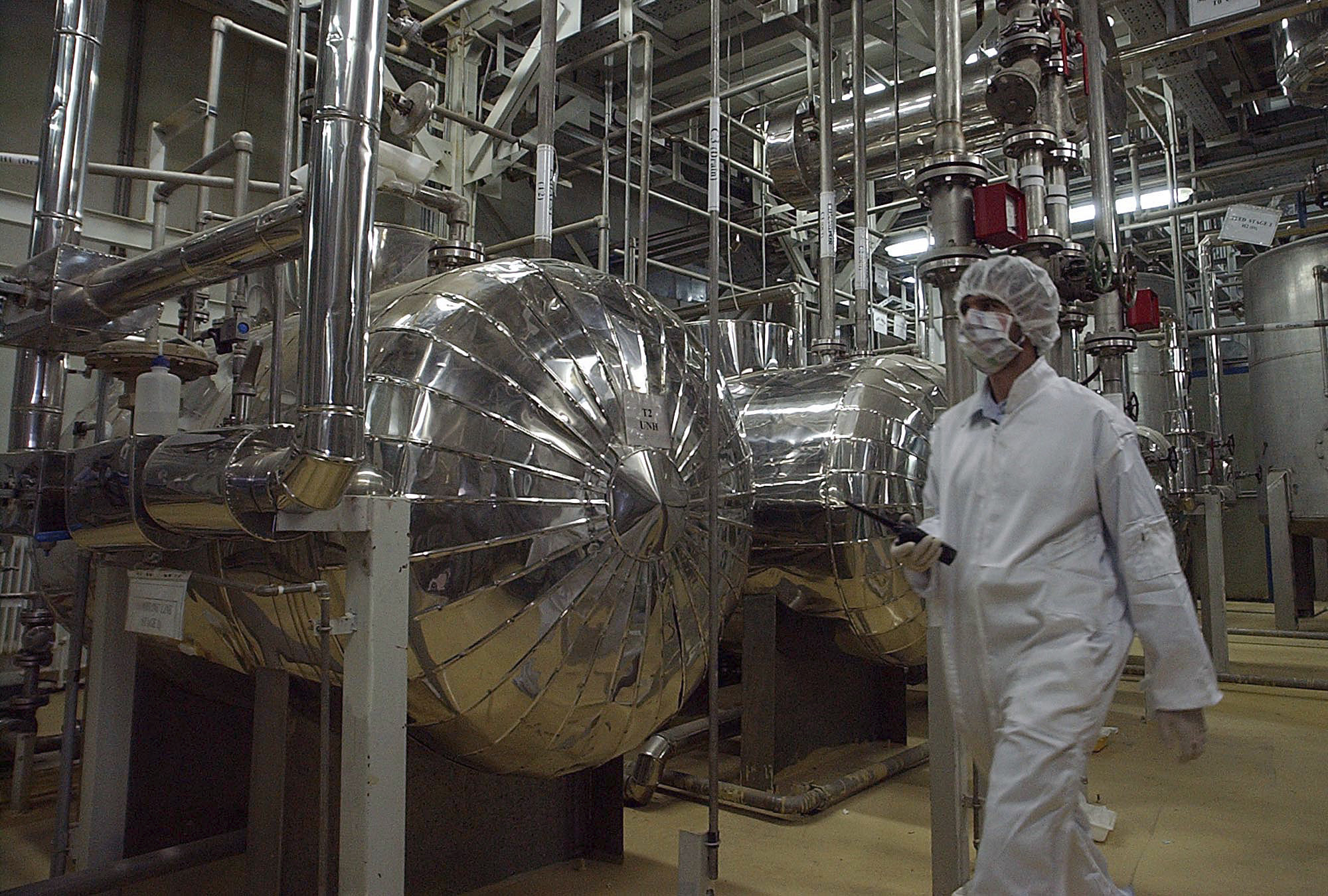
On June 13, Israel began a series of decisive strikes on Iranian nuclear and military sites. The United States continued the job on June 22, delaying Tehran’s nuclear ambitions and, with them, Tehran’s fanatical dash to destroy the Jewish state and usher in an apocalyptic ‘Twelver Paradise.’ The three linchpin nuclear facilities at Fordo, Natanz, and Isfahan were bombed by a combination of 14 GBU-57 Massive Ordnance Penetrators delivered by B-2 stealth bombers and approximately 30 submarine-launched Tomahawk cruise missiles.
But the troubling remnant is 400 kilograms (882 lbs.) of UF-6, composed of 60 percent highly enriched uranium (HEU). Once further processed, this amount is sufficient to make as many as eight to 10 nuclear weapons. Experts differ somewhat on how many kilograms are needed for a single nuclear device, but a grapefruit-sized core of about 30 to 40 kilograms (66 to 88 lbs.) represents a mid-range approximation. Based on China’s breakout times and Iran’s record of advanced weaponization, the regime could plausibly produce deliverable bombs in about a month.
So, take a harder look at what is known and unknown about this cache of UF-6 now in the public eye. UF-6 is the abbreviation for uranium hexafluoride, a key essential feedstock needed for a nuclear bomb. This compound is made by pulverizing uranium ore and treating it with chemicals, especially fluorides, to convert the solid substance into a gas. That gas is UF-6, composed of about 99.3% U-238. The rest of the gas is the bomb-quality U-235.
Subjecting the UF-6 gas to centrifugal force, using centrifuges spinning as rapidly as 1,500 revolutions per second or 90,000 rpm, causes the heavier U-238 to fall to the bottom of the centrifuge. The remaining U-235 is the distilled bomb-quality matter. Spinning millions of molecules millions of times in long cascades of linked, ultra-fast centrifuges slowly yields a quantity of potent U-235. When the processed UF-6 is enriched to 90% U-235, the result is bomb-grade HEU.
Speculation has arisen about where Iran’s stock of UF-6 was, where it is now, and whether it was moved just before Operation Midnight Hammer collapsed everything at the three main facilities, Fordo, Natanz, and Isfahan.
Many saw satellite images of hauler trucks lined up at the entrance to Fordo. Experts have since concluded that these construction trucks were used to create a large, last-minute high-performance reinforced concrete barrier above the facilities’ ventilation shafts. America’s MOPs were not impeded, as their recently added Large Penetrator Smart Fuses were adjusted to pause during penetration until they reached the desired depth.
Moving UF-6 is not an easy task. UF-6 is highly caustic, corrosive, and all-around dangerous. Inhalation can be fatal. Contact with moisture changes its chemical structure. At room temperature, UF-6 is a solid, generally displaying a snow-white appearance. Only as its temperature increases does the compound become the rare gas needed for enrichment. Hence, the temperature of stored UF-6 must be constantly regulated.
UF-6 is stored and transported in special 30B cylinders, generally more than four feet tall and constructed of dense steel and other strong materials. Iran’s nuclear engineers usually utilized bright-blue 30B cylinders for easy recognition. Simply standing close to one of these cylinders for two hours generates radiation exposure equivalent to a dental X-ray. When loaded and readied for transport, 30B cylinders and their packing can weigh 3 tons each, only half of which is the potent UF-6. Iran would only need a single cylinder to accommodate its 400 kilograms of HEU. That quantity could be transported in a single Ford F-150 pickup truck equipped with a compact carrier offering proper temperature controls.
Then what? The percentages can be confusing. The UF-6 must be further enriched to 90% HEU. But at 60%, the task is already 95% complete. The question is, where are those extra cascades of linked centrifuges to finalize the enrichment? The complexes of Fordo, Natanz, and Isfahan were destroyed by the tremendous percussive power of 14 Massive Ordnance Penetrator bombs (MOPs), each weighing 30,000 lbs. Centrifuges, including the advanced homegrown IR-6s, are so delicate that just slowing them abruptly can cause a breakdown. That’s what the Stuxnet virus did; it slowed down and sped up the centrifuge blades, which produced premature breakdowns.
The three targeted facilities at Fordo, Natanz, and Isfahan may have collectively housed cascades of more than 18,000 centrifuges. Those are gone. Israel also hit the Tehran Research Center, which manufactured advanced centrifuge rotors created with carbon fiber to ensure their durability. A centrifuge manufacturing lab in Karaj was also bombed out of commission.
Iran likely stored some centrifuges at some of its 24 other nuclear facilities. But to reestablish molecule-by-molecule cascade enrichment to achieve 90%, the stock of UF-6 would have to be siphoned out of its protective transport cylinder and into a working centrifuge cascade — if one existed. This means the Iranians would not only have to deploy centrifuges from some storage and assembly area but also array them into a sophisticated cascade erected under laboratory conditions.
Plus, a transfer mechanism would be needed. UF-6 transports in a solid crystalline mass. Those crystals must be carefully warmed to sublimate into a gaseous form for the centrifuges. Finally, before being decanted into the cascades, the UF-6 must be purified via ultra-sensitive chemical traps to filter out trace impurities, including hydrogen fluoride and fluorine. Only after this purification can the gaseous UF-6 be ducted into the cascade of centrifuges to distill the U-235. All of this action would set off clandestine radiation detection systems that remain in place, both on the ground and soaring above in orbit.
If Tehran somehow reestablished an enrichment facility in some unseen corner, the potent UF-6 would be ready for the next step: metallization. Transforming the UF-6 gas into a metal, once it reaches 90% HEU, requires a complex chemical conversion, manufacturing, and metallurgical assembly line. Such a facility is unlikely to remain undetected.
To metalize, the UF-6 must first be converted into another substance known as UF-4. Engineers accomplish this by adding hydrogen, that is, uranium tetrafluoride, also known as ‘green salt.’ This green salt is then blended with magnesium or calcium metal chips. The mix is superheated in a special, highly reinforced ‘bomb reduction vessel.’ Nuclear engineers call the elaborate HEU melting unit a ‘bomb’ even though no bomb effect is possible. The melted slag collects at the bottom of the vessel, accreting into a dense ‘direct reduction ingot’ known as a ‘dingot.’ The process must be repeated and continually inspected for residues. Once enough dingots are collected, they are shuttled to another furnace for smelting and spheroidization. This is the final step, shaping the mass into the dangerous bomb core to be placed into a warhead.
Converting UF-6 gas to crude metal and then forming the slag into a sphere is a complex, multi-step process requiring furnaces, ventilation, vacuum pumps, molds, tooling, special storage vessels, and precise processing equipment. Two separate labs would probably be needed — one to smelt, and the other to shape the spheroid. Once elaborate metallurgy plants have been constructed, the smelting process is rapid, taking as little as 50 minutes. But the process may have to be repeated over and over again if impurities are encountered.
Finally, the dangerous ball must be delicately wedged into the R-265 shock generator warhead lined with PETN-laden channels, which creates an implosion measured in microseconds — that is, millionths of a second, when detonated. The monumental force of the implosion is absorbed by the durable exploding bridgewire fuse, which transduces that awesome collected power into a neutron initiator that fires its single stray neutron into the unstable spheroid core of 90% HEU. Delivered in the nosecone of a Shahab-3 missile, the process rocks nature and creates at 550 meters (1,640 feet) above sea level, a mushroom cloud that will incinerate everything within roughly six to eight miles, fatally poisoning and mass murdering many more, and devastating much more beyond the blast radius.
The process needed to convert the 400 missing kilograms of UF-6 is too elaborate, too multi-staged, and too industrial to be executed surreptitiously, whether in a barn or in a new, mysterious nuclear facility now under development at Pickaxe Mountain, just down the mountain from the Natanz enrichment complex. The errant UF-6 cylinder could feasibly be transported inside the hull of an Iranian oil tanker. Iran has militarized several converted oil tankers, including the IRIS Makran, the IRIS Kurdistan, and the Shahid Bagheri. Tehran could even consider secretly relocating part or all of its bomb-making process extraterritorially to a renegade area such as Yemen. The UF-6 cylinder can easily travel by ship, rail, or truck, as long as it rides in an environmentally controlled casing.
The question is whether the ayatollahs are determined to reestablish the process and finish the job. It is now universally understood that if detection reveals a restart, Israeli kinetics will resume — and if necessary, American resupply or strategic participation will amplify any post-Rising Lion strike.
Everything above this line reflects information that the most knowledgeable analysts and scientists will generally explain about HEU at 60%, and the necessity to enrich to 90% to produce a weapon-strength core. Everything below here offers a terrifying footnote that the most careful experts all know but are generally not mentioning. That footnote cautions that although we commonly speak of weapons-grade HEU as a 90% enriched product, in many ways that is a frightening fallacy.
Iran could make a nuclear bomb with HEU enriched to only 20%, and surely with just 60% stock. Size matters. So, miniaturization is needed to fit the dense nuclear spheroid into the compact R-265 warhead designed to wedge into the tight confines of a 9.8-foot Shahab-3 nosecone, or into the even more perilous Ghaem-100 space-launched missile capable of an oblique exospheric reentry angle. However, if Iran is willing to create a larger device — say, the size of a Volkswagen bus or a shipping container — or an underground test prototype, it could easily do so.
Since the spring of 2022, arms control experts at the United Nations and various governments have known that Iran had crossed the burning threshold to 60% enrichment. Back then, the International Atomic Energy Agency warned that Iran could adapt any bomb design to utilize its 20% and 60% enriched stocks and achieve breakout within weeks. Its production rate of 60% HEU amounted to 4.5 kilograms (10 lbs) per month, which meant enough HEU for one oversized bomb every two months.
Moreover, Iran had learned at Fordo that its technicians could skip an older cascade and truncate the enrichment process by utilizing a single advanced IR-6 cascade, thus speeding up the bomb schedule. At the time, the new and faster IR-6 centrifuges were just replacing the older IR-1 centrifuges. Inspectors discovered that Iran was converting its HEU gas into 5.8-gram metal plates. Some 88 of these small bomb-quality plates had already been cast. Accumulating enough of these small plates could make the 50-minute smelting process yield the required spheroid in a single day.
Warhead designs differ radically, and scientific estimates vary with them. But a number of experts conclude that a large enough accretion of just 20% U-235 is sufficient to create a deadly chain reaction resulting in a mushroom cloud. How much? About 400 kilograms. How much HEU is missing in Iran? About 400 kilograms.
Military historians remember well that Little Boy, dropped on Hiroshima, contained only 80% HEU.
At 60% HEU, arms control experts believe two or three non-miniaturized bombs can be readied, depending upon their design and delivery method. This means that the errant UF-6 is either mid-stream to weaponization but unusable because it is buried beneath tons of rubble, or stealthily relocated to another site where it can be later turned into a weapon of mass death and destruction.
The key ingredient is not a radical radioactive isotope, but radical religious fervor. As long as the ayatollah regime is heaven-bent on developing the worst weapons on Earth to annihilate Israel, the only reliable act of nuclear disarmament for Iran, the sole chemical antidote to HEU, is regime change. That would require a different sort of chain reaction and critical mass.
Edwin Black is the award-winning, New York Times-bestselling author of “IBM and the Holocaust” and the just-released scoop volume “Israel Strikes Iran: Operation Rising Lion — The 20-Year Backstory,” which can be found at IsraelStrikes.com.

